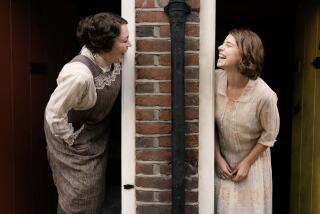Is ‘Downton Abbey’s’ middle child just like your family’s?
Laura Carmichael is not an aristocrat, but she plays one on television: Lady Edith, the middle daughter on “Downton Abbey.”
And I’m not a psychologist, but in the same spirit, I can play one when it comes to a television character, and figure out how Lady Edith fits into some of the birth-order behavior theories. Because at long last, this may be her big moment on “Downtown Abbey,” perhaps snagging the older man she’s been angling for.
Let’s review the research, some of it soundly academic, some of it pop-culture-book-at-the-airport-gift-shop:
The other “Downton” daughters fall pretty much into birth-order stereotypes: Mary, the eldest, confident, inclined to bossiness, a leader but more traditional than not. Sybil, the youngest, the rebel, the risk-taker. Mary is the one who is most anxious to preserve Downton and its way of life; Sybil marries the Irish chauffeur, who would just as soon turn Downton into a home for aging Fenians.
Something like half of U.S. presidents and Nobel Prize winners are firstborn or only children; later-born and youngest children are likelier to throw out the old and embrace the new -- revolutionaries such as Charles Darwin, Thomas Jefferson, Harriet Tubman and Voltaire.
That leaves us with Edith, the less-lovely sister and the middle child. She’s the invisible one, the one whose own father remarked of her: “Poor old Edith. We never seem to talk about her.”
It reminds me of some lines in the brilliantly written film “The Lion in Winter.” The sons of England’s King Henry II are openly scheming against him; the middle-ish one, Geoffrey, grumbles: “No one ever thinks of crown and mentions Geoff. Why is that?” He is reminded that he’s been given a dukedom and the position of chancellor, and isn’t that power enough? “It’s not the power I feel deprived of,” mopes Geoffrey. “It’s the mention I miss.”
Too bad they were separated by more than 700 years. Edith of Downton and Geoffrey of Brittany would have made a perfect couple.
Edith is a middle-child paradox. Middles are supposed to be the quiet ones, which she is, but they’re also supposed to be the agreeable ones, the peacemakers. And yet we see her jealously bringing scandal to the family by tattling on Mary’s death-dealing romp with a Turkish diplomat. We see her lovelorn, kissing a local farmer, getting taken in by a Crawley impostor, all but throwing herself at her cousin Matthew and then all but proposing to a diffident older beau.
She seems to come into her own only during World War I, when she runs a military convalescent operation at Downton, and, to the shock of her family, wins praise from a visiting general.
Middles are the most unknowable and least predictable. They’re often overshadowed by the eldest’s high-handedness and triumphs and the youngest’s charm and flamboyance.
They can be, said psychologist Kevin Lerman, resentful of all the attention the elder gets and the parental inattention that benefits a youngest child in the form of more indulgent rules. Middles, he said, tend to rely on their own resources, often outside the family that may pay them little mind.
Frank Sulloway, in his definitive academic book “Born to Rebel: Birth Order, Family Dynamics, and Creative Lives,” takes the study of birth order out of the British kingdom and into the animal kingdom, writing about sibling competition for resources and the not-unknown gruesome phenomenon of “siblicide,” which is a word I am so ready to use in case Edith decides to murder her younger sister, Sibyl.
If that turns up in a later episode of “Downton,” that means that either I’m psychic, or “Downton” creator Julian Fellowes is reading this and taking notes …
All right, Lady Edith: Lights … camera … you’re on! We’re all watching, for once.
ALSO:
Huell Howser was the real deal
Could you work at Downton Abbey?
More to Read
A cure for the common opinion
Get thought-provoking perspectives with our weekly newsletter.
You may occasionally receive promotional content from the Los Angeles Times.







